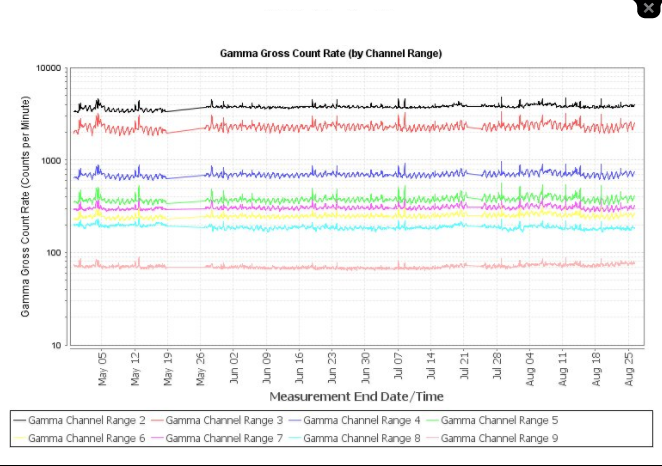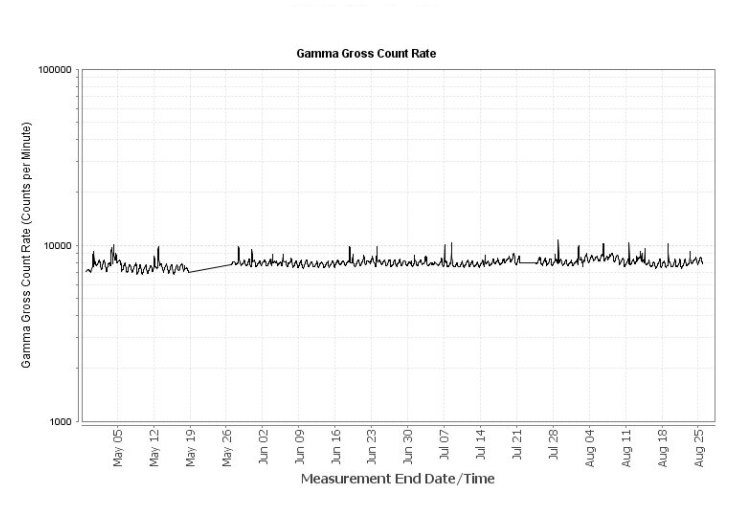Frequent Questions: RadNet Near-Real-Time Air Monitoring
View frequently asked questions about the RadNet near-real-time air monitoring.
On this page:
- How often are RadNet’s near-real-time air monitoring data updated on the EPA website?
- Why do I see higher levels of radiation at some monitor locations?
- Why did the EPA decide to add exposure rate measurement capability?
- What is a normal background exposure rate?
- What happens if air monitors report radiation levels outside of normal background levels?
- What is gamma gross count rate?
- When will my RadNet station get exposure rate measurement capability?
- How does gamma gross count rate relate to exposure rate?
- Why aren't the results for my location up to date? Why are there gaps in data?
- What is the relationship between exposure rate and dose rate?
- Why are there fluctuations in near-real-time air data at a single monitoring location?
- What do the different gamma channel ranges illustrate? What does each range represent?
How often are RadNet’s near-real-time air monitoring data updated on the EPA website?
RadNet near-real-time air data are refreshed hourly during business hours, Monday through Friday. This hourly refresh ensures that the most up-to-date data are available for the last 24 hours.
NOTE: All results are shown in Coordinated Universal Time (UTC).
Why do I see higher levels of radiation at some monitor locations?
The normal background radiation levels in one location may be different from the normal background radiation levels in another. The normal background level of radiation at any one location depends on factors including:
- Altitude (monitoring data from higher altitude locations may show a higher level of normal background radiation because of a greater contribution from cosmic radiation).
- The amount of naturally-occurring radioactive materials in the soil and air.
- Weather conditions (for example, rainfall, snowfall and changes in atmospheric pressure) may account for variations in measured background radiation levels; some such conditions can cause increases, and others may cause decreases in measured radiation levels.
For more information about background radiation, see Radiation Sources and Doses.
Why did the EPA decide to add exposure rate measurement capability?
Exposure rate measurements indicate the overall level of gamma radiation present in the vicinity of a monitor. The EPA decided to add exposure rate measurement capability to the RadNet system to make monitoring results easier to understand RadNet exposure rate measurements can be compared with results from different RadNet stations and with data from other monitoring stations across the world.
Exposure rate measurement is being added to the RadNet monitoring network incrementally over time, and this capability is an enhancement to the existing network. The EPA’s RadNet network will continue to report gross gamma count rate and laboratory analysis results under a routine reporting schedule.
For more information, visit RadNet.
For more information on the reporting schedule, visit RadNet Sampling and Analyses Schedules.
What is a normal background exposure rate?
Background radiation exposure rates normally vary from location to location. There are many factors that influence exposure levels, including naturally-occurring radionuclides in the soil and altitude. For example, the exposure rate from naturally-occurring elements in rocks and soils (terrestrial radiation) may vary by more than a factor of 10.
For more information about typical exposures rates, visit About Exposure and Dose Rates or the Health Physics Society’s Environmental Radiation fact sheet.
What happens if air monitors report radiation levels outside of normal background levels?
RadNet near-real-time air data are screened at the EPA’s National Analytical Radiation Environmental Laboratory (NAREL) to identify anomalous readings. When an anomalous result is reported, the data are flagged for review by a trained EPA scientist.
In instances where further review of the near-real-time data is needed, air filter analysis from the monitoring location can present a more complete picture of the cause of the anomalous values.
What is gamma gross count rate?
RadNet air monitors analyze radiation emitted from particulates collected on air filters. These results are presented as a gamma gross count rate measurement. Measuring data in counts per minute allows EPA scientists to detect anomalies by tracking changes over time.
When will my RadNet station get exposure rate measurement capability?
It will take time for the EPA to add exposure rate measurement to all locations. As part of normal RadNet maintenance, the EPA is adding exposure rate measurement capability to each monitor’s gamma detection system when the currently installed gamma detection system requires repair. Monitors in the ten largest cities, Washington D.C. and a number of other sites already have exposure rate measurement added to their gamma detection system. View the list of RadNet air monitors with exposure rate measurement capability.
How does gamma gross count rate relate to exposure rate?
There is no direct relation between gamma gross count rate and exposure rate. These two measurements are made by separate detectors with different purposes and configurations. The exposure rate data indicate the amount of radiation in the vicinity of the monitor over a period of time (typically hours). In comparison, gamma gross count rates are measurements made by a detector that analyzes radiation emitted from particulate collected on air filter.
Why aren't the results for my location up to date? Why are there gaps in data?
The EPA's RadNet monitors are highly sophisticated devices that occasionally require maintenance and repair. Normally, near-real-time air monitoring data are posted to the RadNet website six times daily. Under certain circumstances a delay in data availability may occur (monitor maintenance or repair, or server/network connection issues). When these situations arise, temporary breaks in reporting appear as gaps in available RadNet data. Once the issues are resolved and the RadNet monitor is returned to normal operation, data should begin to appear.
Also, all data collected by the RadNet air monitors are reviewed for anomalies before they are publicly available on the EPA’s website. Anomalous data are reviewed by EPA scientists, and, if validated, will later appear on the website.
What is the relationship between exposure rate and dose rate?
There is a subtle difference in definition between exposure rate and dose rate. Radiation exposure is a measurement of the intensity of gamma radiation in a location, and is defined in terms of the ionizations created in a given volume of air.
Dose is the amount of energy absorbed by a medium, including human tissue.
For gamma radiation, exposure rate and effective dose rate can be compared as follows--one (1) milliRoentgen per hour (mR/h) is approximately equal to 10,000 nanosieverts per hour (nSV/h).
For more information about typical exposures and dose rates, visit About Exposure and Dose Rates or Learn About RadNet.
Why are there fluctuations in near-real-time air data at a single monitoring location?
It is common to see fluctuations in data at a single location over time due to fluctuations in normal background radiation. Rainfall, snowfall and changes in atmospheric conditions such as pressure or time of day/night may account for variations in measured background radiation levels; some such conditions can cause increases, and others may cause decreases in measured radiation levels.
What do the different gamma channel ranges illustrate? What does each range represent?
The EPA uses RadNet monitors to track fluctuations in gamma radiation emitted from airborne radioactive particles at each air monitoring site. Tracking these changes over time gives a picture of the normal, background levels at each monitoring location and allows EPA scientists to detect any unusual changes. A graph of near-real-time air results by gamma channel range can be viewed on individual monitoring webpages or results can be downloaded in CSV format on the RadNet CSV File Download webpage.
The gamma gross count rates measured by RadNet air monitors show how many gamma rays the monitor detects each minute. These measurements are sent to the EPA’s National Analytical Radiation Environmental Laboratory (NAREL) at regular intervals throughout each day for review and processing by trained EPA scientists.
Data are split into gamma channel ranges to allow EPA scientists greater sensitivity when identifying anomalous readings. When multiple hours of data are looked at together we can track "normal" or "background" radiation levels at each air monitoring location.

Adding the channel ranges together provides a broader-scale view of trends at each monitoring location.

When the RadNet computer system detects an elevated reading from an air monitor in any of the ranges, those data are reviewed by EPA scientists who are specially trained in understanding the data and identifying specific radionuclides.
